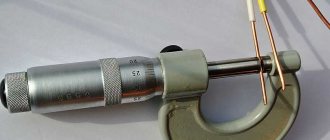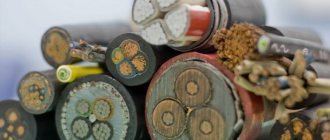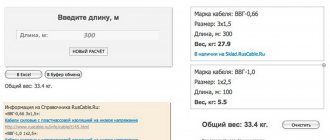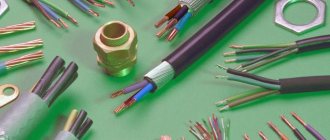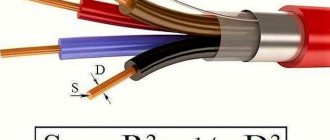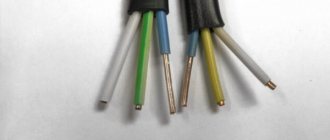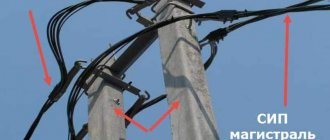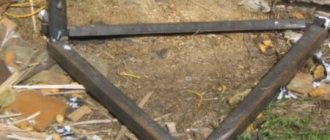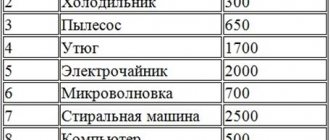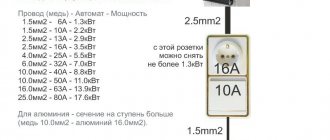You can often find electrical products in supermarkets without tags or identification marks. Among it there could easily be a coil of wire or cable. How do you know if the wire size is appropriate for your specific situation? The answer is simple - measure it or consult the seller.
Anyone who sells cables and wires can tell you what load they can withstand. In addition, inscriptions (numbers) are stamped on the wires, characterizing the cross-section and number of cores. But in real practice, not everything is as simple as it seems. The quality of cable products has recently deteriorated noticeably.
How to determine wire cross-section
- 1 Serious question
- 2 How can you determine the cable cross-section
- 3 Simple method for determining diameter
- 4 How to measure the cross-section if the wire is stranded
- 5 Videos
One of the important and basic parts of electrical wiring is the cables that conduct current. In order for everything to work as it should, without short circuits and melted wires, it is important to select the wiring so that it can withstand the voltage. You can make sure that the wire is reliable, safe and meets operating requirements by calculating the wire cross-section. If the wire is of insufficient cross-section, it can lead to a short circuit and fire in the house. Let's figure out how to determine the wire cross-section to avoid such consequences.
Why do you need to calculate the cable load?
This question often arises when installing wiring in an apartment or home. First, all planned loads are considered, and then the required wire cross-section is determined. Then the necessary material is purchased from the store and electrical wiring is installed in the house.
As a result of using new wiring, the circuit breaker on the electrical panel first “knocks out”, and then damage to the wire is discovered. Moreover, it often turns out to be completely melted, as a result of which a short circuit occurs. It turns out that the calculations were made incorrectly, and how can you find out the minimum permissible value of the wire cross-section in this case?
To avoid serious overloads, it is necessary to calculate how many electrical appliances in the apartment will be used simultaneously. Among the most powerful household appliances that are usually used at home when preparing food and creating our comfort are:
- electric stove;
- air conditioner;
- microwave;
- electric kettle;
- iron;
- washing machine and dishwasher;
- coffee grinder;
- vacuum cleaner.
The power consumption of these household appliances ranges from 1 to 2 kilowatts (with the exception of electric stoves).
Important! If the cross-section of the wire is indicated incorrectly (underestimated), then when using it, it is natural for large overloads to occur, which lead to a fire in the wiring.
Method 1: Vernier caliper
The most common method, as it requires only a caliper and basic knowledge of mathematics. Used for wires with round core cross-section.
- Strip the cable core from the insulation using a special tool, a sharp knife, or melt it (the insulation) with a torch.
- We measure the bare end of the wire in diameter using a caliper.
- Next, you need to arm yourself with knowledge from a school geometry course. As you know, the area of a circle is equal to the number “Pi” multiplied by the square of the radius.
- Since a caliper allows you to get the diameter, you need to divide the resulting value by 2.
- We square the radius value and multiply by the number “Pi”. Such calculations do not require high accuracy, therefore (as in school) it is acceptable to round the value of “Pi” to 3.14.
- The result obtained is the cross-sectional area of the cable. We compare it with the specified value to determine compliance and identify defects, or compare it with the table of permissible currents to determine whether the product is suitable for your network.
Let's take a cheap cable of unknown origin with a specified cross-section of 4 mm2. The caliper showed that the diameter of the core was 2.2 mm. Divide by 2, we get 1.1 mm. The square of this number is 1.21. Multiply by 3.14 and get 3.8 mm (rounded). As can be seen from the calculation, the real indicators do not correspond to the declared ones, which indicates the manufacturer’s dishonesty.
Method 2
This method requires a mechanical or electronic caliper and a micrometer.
Measure with a micrometer. The device has two main parts - handles and semicircular recesses for measuring. The wire is inserted into the micrometer connector, the handle is screwed in until it stops. When the screws come together on the sides, turn the ratchet on the handle of the device until it begins to scroll. The measurement has been completed and is shown by the scale on the micrometer drum.
An electronic micrometer shows accurate numbers, which eliminates human calculation errors.
Calculation of the cross section using a caliper. For proper use, you need to know the structure of the device. It consists of a scale with 1 mm markings, the length of a standard ruler is 15 cm, a measuring sponge, a ruler for depth, and a screw for clamping an object.
Cut the cable and separate the wires. Clear one of them. Spread the jaws, insert the core so that the jaws fit tightly. Secure with screw. Now you can see the length of the object. Next we calculate according to the already known formula.
How to find out the cable cross-section by the diameter of the core
Greetings, friends!
You are making repairs and decide to change the electrical wiring yourself. And now you need to select a cable. What do you need to do? You need to go and buy cables for your repair, unless, of course, you are the owner of a cable factory.
But what do we have in store? And there is very little choice. Both TU and GOST. But even a cable made according to GOST does not guarantee you the technical data declared by the manufacturer. Manufacturers, wanting to reduce the cost of producing their products, use various tricks. And one of them is underestimating the cross-section of the cable cores. I'm not even talking about TU cables, everything is bad there. Once I measured the cross-section of the cable TU VVG Zx2.5, so in general it was one and a half squares.
The thickness of the cable core insulation is also reduced. But we will talk about the section.
Of course, a cable produced in accordance with GOST has an advantage over TUSH cable. But its price is also much higher. Therefore, in order to reduce the cost of repairs, many use TU cable. Among the products produced according to the Technical Specifications, there are more or less high-quality products. But it is not possible to determine the cross-section of the cable core by eye (only approximately), so I will tell you how to do this quite accurately.
What can we measure on a cable? Diameter only.
How to choose the cable cross-section when installing electrical wiring?
The choice of wire cross-section in this case depends on the permissible current density delta, which is measured in A/mm². This current density shows the load on the wire, and depends on the operating conditions, which can vary from 2 A/mm² - for closed wiring and up to 5 A/mm² if the wires are in fireproof insulation. The required wire diameter can be determined by the selected current and its density value using the following formula:
In the case of electrical wiring, the current density delta ( Δ
) equal to 2 A/mm², and then the above formula is converted into:
The wire cross-section can be found using the following formula:
This current density value of 2 A/mm² is chosen with a large margin because the electrical wiring is embedded in the wall, and it is very difficult to get burnt electrical wiring out from under the plaster and finishing of the walls.
The cross-section of the cable and wire for closed wiring is taken to be 30% larger than for open wiring, since in the hidden version the cable is practically not cooled.
Tips from an electrician
We've provided existing methods, but that's not all.
We recommend that you familiarize yourself with the following tips from experienced electricians on determining the wire cross-section:
- In addition to the cross-section of the product, pay attention to the metal of the core. The copper or aluminum core must have a characteristic rich color. If the color is questionable, then most likely it is an alloy of metals, which allows the manufacturer to save money. Such an alloy is extremely dangerous for installing electrical wiring in the house, because... its current conductivity and rated loads are several times less than that of the original product.
- The cross-section needs to be determined only by the core. Even if the product appears to be of normal thickness, it is possible that the reduced dimensions of the core were compensated by an increased layer of insulation.
- If you are in doubt about the size of the conductor, purchase a larger gauge wire. The power reserve will definitely not damage your electrical wiring!
- If you are dealing with a cable, the calculation will be slightly different (due to the fact that the cable may consist of n number of wires). To correctly carry out the calculations, you must first determine the diameter of each individual wire, then sum up all the values and select products according to the final number.
Calculation of stranded conductors
The calculation of the wire cross-section by diameter for a stranded conductor is carried out similarly to a single-core one, however, it is necessary to take into account the correction for the number of cores. The resulting value is multiplied by this amount, and a wire is selected based on this new value. The most difficult problem in such calculations is measuring the diameter of a thin core. Indeed, often in such conductors they have very small cross sections and their measurement is difficult. If, however, it was possible to measure, then the next main criterion for selecting a cable is the conductivity of the wire. As a starting point, the current conductivity of one core is chosen, and only then, using the corresponding dependencies, they arrive at the final value. Based on the general conductivity, the cross section is already selected using the appropriate tables and standards.
Thus, you can select the cable cross-section based on its planned dimensions and current conductivity. And despite the fact that this article does not pay much attention to the second point, it is necessary to understand that it is fundamental in selecting a cable. The so-called rupture current is the line beyond which the electrical system can not only fail, but also provoke extensive, all-destructive fires.
Source: glav-dacha.ru
How to measure the cross-section of a wire with a caliper
Table of correspondence of wire diameters and their cross-sectional area
You don’t always want or have the opportunity to make payments in a store or on the market. In order not to waste time on calculations or to avoid making mistakes, you can use the table for the correspondence of diameters and cross-sections of wires, which contains the most common (normative) sizes. You can rewrite it, print it and take it with you.
| Conductor diameter | Conductor cross-section |
| 0.8 mm | 0.5 mm2 |
| 0.98 mm | 0.75 mm2 |
| 1.13 mm | 1 mm2 |
| 1.38 mm | 1.5 mm2 |
| 1.6 mm | 2.0 mm2 |
| 1.78 mm | 2.5 mm2 |
| 2.26 mm | 4.0 mm2 |
| 2.76 mm | 6.0 mm2 |
| 3.57 mm | 10.0 mm2 |
| 4.51 mm | 16.0 mm2 |
| 5.64 mm | 25.0 mm2 |
How to work with this table? As a rule, the cables have a marking or tag indicating its parameters. The cable marking, number of cores and their cross-section are indicated there. For example, VVNG 2x4. We are interested in the core parameters and these are the numbers that appear after the “x” sign. In this case, it is stated that there are two conductors having a cross section of 4 mm 2. So we will check whether this information corresponds to reality.
How to work with a table
To check, measure the diameter using any of the described methods, then check the table. It states that with such a cross-section of four square millimeters, the wire size should be 2.26 mm. If your measurements are the same or very close (there is a measurement error, since the devices are not ideal), everything is fine, you can buy this cable.
Stated sizes do not always correspond to real ones
But much more often, the actual diameter of the conductors is much smaller than the declared one. Then you have two options: look for a wire from another manufacturer or take a larger cross-section. Of course, you will have to overpay for it, but the first option will require a fairly long period of time, and it is not a fact that you will be able to find a cable that complies with GOST.
The second option will require more money, since the price significantly depends on the declared cross-section. Although, it’s not a fact - a good cable made according to all standards may cost even more. This is understandable - the cost of copper, and often also for insulation, subject to technology and standards, is much higher. That’s why manufacturers cheat by reducing the diameter of the wires in order to reduce the price. But such savings can turn into disaster. So be sure to take measurements before purchasing. Even trusted suppliers.
And one more thing: inspect and feel the insulation. It should be thick, continuous, and have the same thickness. If, in addition to changing the diameter, there are also problems with insulation, look for a cable from another manufacturer. In general, it is advisable to find products that meet the requirements of GOST, and not made according to specifications. In this case, there is hope that the cable or wire will serve for a long time and without problems. It's not easy to do these days, but whether you're wiring your home or running electricity from a utility pole, quality is very important. Because it’s probably worth looking for.
Serious question
If you plan to replace electrical wiring, then first of all you need to decide what cross-section of wire is needed. When you calculate the planned current load on the wire, it will immediately become clear what cross-section is needed for normal operation. For this purpose, use the table below.
Current selection
Let's say, having calculated everything, you have determined the current strength to be 27 A. It turns out that you need a two-core wire with a cross-section of 2.5 mm2. You went to the store, bought a good wire, with a cross-section of 2.5 mm2 declared by the manufacturer, and installed the electrical wires. After the time has passed when the system was up and running, the machine on your dashboard turns off. This may indicate a damaged line.
After you inspect the wiring, you may find that there was a short circuit. The reason is simple - the insulation on the wire melted due to strong heating. But how can this be? You did everything right, calculated it, purchased the necessary wire. And the whole point is not in the calculations and your error with the connection. The whole reason lies in deception. Yes, precisely in deception, since very often manufacturers producing wires supply goods that do not correspond to the declared cross-section. For example, you bought a cable with a wire area of 2.5 mm2, but when you checked it yourself, it turned out that the cable cross-section is only 2.1 mm2, which is less than what you need in terms of power. So it turns out that the wire heats up, and the risk of a short circuit increases.
Wire with damaged insulation
But why would cable companies do this? It's all about greed, since by lowering the cross-section of the wire, the manufacturing company saves quite a significant amount of money. Judge for yourself: to make 1000 m of wires with a cross-section of 2.5 mm2, you will need approximately 22.3 kg of copper. But if you make them with a smaller cross-section, 2.1 mm2, then their production will require 18.8 kg. It turns out that the savings in favor of the manufacturer are 3.5 kg of copper. And when large volumes of products are produced, this figure increases significantly.
So it turns out that determining the wire cross-section is an important and serious step that must be performed when installing wiring. This way you can avoid insulation melting, short circuits and, as a result, fire.
How to determine whether the parameters match?
As a rule, extreme care on your part allows you to avoid such incidents during the purchase:
- A normal wire must have its marking, which provides the buyer with all the information about the model, operating features, and parameters. If you encounter questionable products, you may find that the product data is not presented in full or is completely missing.
- If the conductor is really good, he must be provided with quality certificates. The technical documentation indicates that it was not only manufactured in accordance with the ND, but also passed the appropriate tests.
- A good wire cannot cost a penny - since the price of materials is quite high, the cheapness should make you wonder if there is some kind of catch in this. If you wish, you can come to the store with a micrometer or caliper and perform a test to clear your doubts.
vote
Article rating
